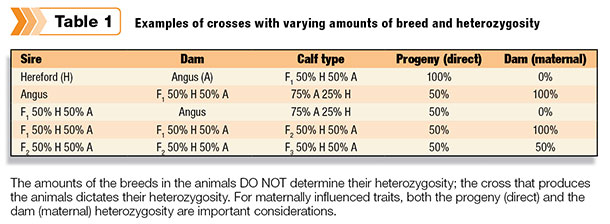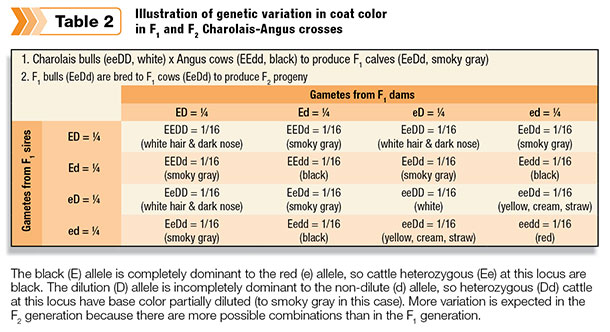This concept could be true on a very limited scale; however, our industry would be unable to meet variable consumer demands, cope with different production environments and accomplish desired change over time without genetic variability.
Animals have places in their genetic makeup (called the genome) where genes are located (gene locus, singular; gene loci, plural). Different forms of genes (referred to as alleles) can exist, and animals inherit one allele from each parent at each gene locus, so each allele has a 50-50 chance of being passed from parent to progeny (except for the sex chromosomes).
Individuals at each locus can have two copies of the same allele (homozygous) or have copies of two different alleles (heterozygous).
For commercial cattle producers, hybrid vigor (also called heterosis) is very important to help improve many performance traits, particularly related to female fertility, longevity, and calf health and growth.
Historically, the dominance model (which is based on breed heterozygosity) has been used to predict hybrid vigor retention in composites past the F1 generation. This theory seems to work fairly well among Bos taurus-Bos taurus crosses, but its usefulness appears variable among Bos indicus-Bos taurus crosses.
Table 1 shows some different possibilities for calf types and heterozygosity.

If the most desirable phenotype is a heterozygote (such as black baldies, roans, blaze faces, etc.), then the cross that provides for the highest percentage of these desired progeny will involve mating of parents different from each other.
For example, mating homozygous black bulls to Hereford cows will produce 100 percent black baldy calves (although not all calves will have the exact degree or amount of white on their faces); conversely, breeding black baldy bulls to black baldy cows would produce some calves that are black baldies but would also produce several other color patterns (solid black, solid red, red baldy, black with Hereford pattern, red with Hereford pattern).
Table 2 shows an example of how this color variability occurs. This concept is also why the only way to produce an F1 is by breeding parents of two different breeds (and the parents are also different genetically from the progeny).

Producers should ask for more information on animals offered for sale that are “F1 type,” as F1 animals are genetically unique compared to other crosses, and having the same color pattern does not guarantee the same genetics. ![]()
Andy Herring is in the Department of Animal Science with Texas A&M University. Email Andy Herring.







